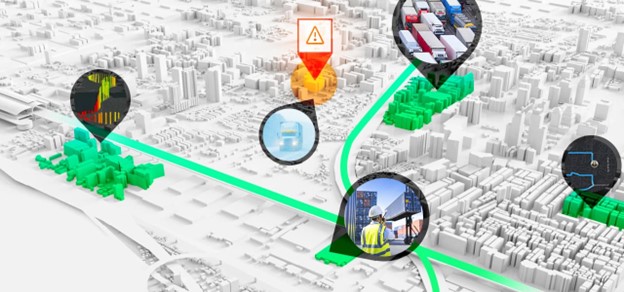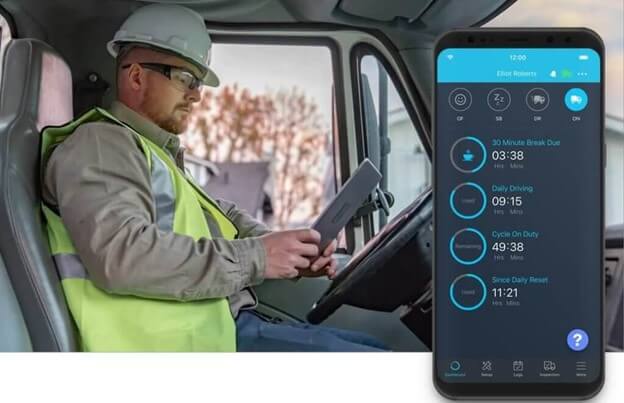Dispatch management software is a type of software that is designed to help businesses manage their dispatch operations. Companies that need to dispatch a fleet of vehicles or other mobile assets to various locations frequently use this software. Dispatch management software is becoming increasingly important for fleet efficiency management, as it helps optimize routes, reduce travel time and fuel costs, and improve customer service.
Fleet efficiency is crucial for businesses that rely on transportation for their operations. A well-managed fleet can help reduce costs, increase productivity, and improve customer satisfaction. However, managing a fleet can be challenging, especially when dealing with a large number of vehicles and drivers. This is where Dispatch Management Software comes in, providing fleet managers with the necessary tools to streamline their operations and maximize efficiency.
In this blog post, we will discuss the six key features of dispatch management software that can help increase fleet efficiency.
Six Features for Increased Fleet Efficiency
1. Real-time Tracking
Real-time tracking is a technology feature used to monitor the location and status of vehicles, assets, or people in real-time. It is achieved using GPS technology to provide fleet managers with up-to-the-minute information on the location and movement of their vehicles. With this information, fleet managers can better manage their fleet operations, optimize routes, and respond quickly to changes or emergencies.

Benefits of Real-time Tracking in Fleet Efficiency
- Better Efficiency – Real-time tracking enables fleet operators to optimize their operations by tracking vehicle location, route, and performance data. This information allows for more efficient routes, fuel savings, and increased driver productivity, resulting in a more productive and efficient fleet.
- Increased Driver Safety – Real-time tracking promotes driver safety by identifying risky driving behavior such as speeding, abrupt braking, and acceleration. Fleet managers can use this information to provide targeted driver training and prevent accidents. This also alerts fleet managers of potential safety concerns, such as unauthorized vehicle use or travel at unusual times.
- Improved Asset Management – Real-time tracking enables fleet operators to manage their assets better by providing data on vehicle performance and location. This information can be used to optimize resource utilization, minimize downtime, and extend vehicle life. Additionally, fleet managers can use this data to plan maintenance, identify potential issues, and manage vehicle depreciation.
- Improved Customer Service – Real-time tracking improves customer service by providing accurate vehicle location and arrival time, reducing waiting times, and enhancing customer satisfaction. It also helps fleet managers proactively address potential delays or issues, leading to an overall improved customer experience.
- Cost Savings – Real-time tracking helps fleet managers save money by optimizing routes, reducing fuel consumption, and enhancing asset management. Real-time data enables managers to find the most economical routes, reduce vehicle wear and tear, and decrease downtime, which contributes to the fleet’s overall profitability.
Real-time tracking can optimize delivery routes and schedules for a delivery company. It can also help a construction company monitor vehicle and equipment movement for efficiency. Overall, real-time tracking is a powerful tool for fleet managers to improve the efficiency and safety of their operations.
2. Route Optimization
Route optimization is a feature in fleet management software. It utilizes algorithms to determine the most efficient route for a vehicle to take. The software considers factors like traffic patterns, road conditions, and distance to identify the shortest and most cost-effective path to reach the destination. The optimization feature can also account for multiple stops, vehicle capacity, and delivery time frames.

Benefits of Route Optimization in Fleet Efficiency
- Improved ETA’s – Route optimization saves time and money while improving ETA accuracy and customer satisfaction. It allows for quick planning of multiple routes and real-time tracking, reducing stress for both customers and businesses.
- Faster Delivery Times – Route optimization helps save time and money for all supply chain stakeholders by ensuring faster delivery times. It simplifies route changes and allows for quick communication, keeping the fleet moving at optimal speed.
- Better Customer Service – Route optimization software improves customer service by providing reliable and efficient delivery, leading to referrals and repeat customers. Customers receive live tracking links via SMS for added control and confidence. It also reduces human error and paperwork, improving the customer experience.
- Reduce Fuel Costs – Route optimization saves fuel costs by accommodating last-minute orders and route changes with minimal fuel spent. It also simplifies communication and reduces idling time, resulting in fewer emissions and lower fuel costs.
- Increased Visibility – Real-time tracking provides visibility, improves communication, and allows for anticipation of issues or delays. It also prevents misuse of company vehicles and helps with budgeting for fuel and costs.
One example of how route optimization can improve fleet efficiency is in the food delivery industry. By optimizing delivery routes, food delivery companies can ensure that orders are delivered quickly and efficiently, minimizing wait times and improving customer satisfaction. This can also reduce food waste by ensuring that deliveries arrive at their destination fresh and on time.
Also Read: Supply Chain Risk Management Software
3. Automated Dispatching
Automated Dispatching is a feature of fleet management software that enables the automation of dispatching tasks. It uses technology like GPS, telematics, and advanced algorithms. It automates the process of assigning drivers to vehicles, routes, and jobs. Fleet managers can assign jobs to drivers based on availability, skill set, and location. They can also track job progress in real-time, making it a valuable tool for improving fleet management.
Benefits of Automated Dispatching in Fleet Efficiency
- Faster Reports That Are Fully Automated – Automated Dispatching simplifies enterprise fleet management by providing trustworthy data faster and with more accuracy. It eliminates oversights and human errors and allows management teams to focus on the bigger picture.
- Better Maintenance Data – Improved access to faster data allows for automation of maintenance monitoring in fleet management, providing information on upcoming repairs and potential part replacements before issues occur. This saves businesses valuable time and prevents downtime.
- Real-Time Insights – Dispatch automation provides real-time data and insights, allowing for quick analysis and resolution of issues in both mechanical and human aspects. This includes information on load temperature, road quality, and driver behavior.
- More Control and More Fleet Operation Information – Automated dispatching solves the challenge of acquiring necessary information for efficient fleet management. With data on fuel usage, route planning, and hazardous driving, businesses have complete control over their fleets, leading to better time management and cost-effectiveness.
- Cost-Saving Measures That Last – Automated dispatching provides long-term cost savings by preventing vehicle damage, avoiding legal costs, and lowering fuel expenses. Implementing automation now leads to significant cost reduction over time, particularly for long-distance fleet services.
- Better Safety – Dispatch automation enhances load and driver safety, leading to cost reduction, flexibility, and real-time insights. This results in a safer workforce and better delivery outcomes. Happier, safer drivers make fewer mistakes and reduce delivery delays.
There are several examples of how Automated Dispatching can improve fleet efficiency. For instance, it can enable dispatchers to assign jobs to drivers who are closest to the job site, reducing travel time and fuel costs. It can also help to prevent the overloading of vehicles by assigning jobs based on vehicle capacity and weight limits. Automated Dispatching can also improve safety by ensuring that drivers are assigned jobs that are within their skill set and experience level.
4. Driver Management
Driver management improves fleet management by monitoring and optimizing driver performance. Technology is used to track driver behavior and provide feedback to help drivers improve their skills. This feature provides fleet managers with valuable insights into driver performance and allows them to optimize their operations accordingly.

Benefits of Driver Management in Fleet Efficiency
- Enhance fleet efficiency – Driver management software enhances fleet operations by providing real-time information. Managers can monitor driver compliance with assigned routes and make adjustments based on weather or traffic conditions. It also includes predictive maintenance features, reducing vehicle downtime and enhancing overall productivity for drivers and managers alike.
- Safety of drivers – Driver management and GPS tracking systems, combined with dashcams, can improve fleet safety by identifying risky behavior and rewarding good habits. This can also potentially reduce insurance premiums and protect against fault in accidents. Bridgestone’s subsidiary has stated that 86% of its users have experienced enhanced safety, while 71% have reported a decrease in accidents.
- Digitise documentation – Digitizing documents through a driver management system allows fleet managers to easily access reports and historical data without the risk of loss or damage. This streamlined inspection process saves drivers time and eliminates the need for paper documents, making it a more effective method for managing drivers.
- Fuel management – Driver management systems can track fuel usage by integrating fuel cards and software, making drivers accountable and allowing fleet managers to monitor fuel transactions against vehicle locations. This helps prevent unnecessary costs due to personal use or fuel theft. In addition, the system can identify efficient routes to reduce fuel consumption. According to a report by Geotab, businesses can reduce fuel consumption by up to 20% by implementing a driver management system that includes fuel usage tracking and route optimization.
- Gain access to telematics data – GPS tracking systems provide real-time information on driver status, location, and productivity, making it an essential tool for safe and efficient fleet operations. Odometer readings allow for preventive maintenance, ensuring timely delivery. GPS systems can also improve driving behavior and offer deep insights for fleet managers, providing a competitive advantage and enabling smarter ways of working.
- Ensure driver policy compliance – Effective driver management strategies are necessary for compliance and business growth. Proper software can help track vehicles and equipment, increasing overall efficiency. Customizable options make it easy to tailor the system to your business needs. Additionally, proactive driver training can eliminate legal and financial consequences.
A global food and drink company that runs a big fleet of delivery trucks is a good example of how driver management can improve fleet efficiency. They used driver management to cut down on idle time and find the best ways for making deliveries. This helped them save more than a million gallons of fuel and cut down on carbon emissions. It also cut down on supply times and made the fleet run more efficiently as a whole.
5. Customer Management
Customer Management is a feature of fleet optimization that allows fleet managers to track and manage their customer relationships. It enables fleet managers to manage customer orders, deliveries, and other interactions while providing real-time data and analytics that can be used to improve customer satisfaction and overall fleet efficiency.
Benefits of Customer Management in Fleet Efficiency
- Improved Customer Service – Customer Management provides fleet managers with a centralized view of customer data, allowing them to quickly and efficiently respond to customer inquiries, orders, and complaints. By providing fast and efficient customer service, fleet managers can improve customer satisfaction and retention rates.
- Enhanced Order Tracking – Customer Management allows fleet managers to track customer orders and deliveries in real-time, providing accurate and up-to-date information on delivery times and order status. This can help improve on-time delivery rates and reduce customer complaints.
- Improved Forecasting – Customer Management provides fleet managers with insights into customer demand patterns, allowing them to forecast future demand and plan their operations accordingly. This can help reduce inventory costs and improve overall fleet efficiency.
- Improved Reporting and Analytics – Customer Management provides fleet managers with detailed reporting and analytics on customer interactions, allowing them to identify areas for improvement and optimize their operations accordingly.
A delivery service company implemented a customer management system to keep its customers informed about the status and location of their deliveries in real time. This resulted in improved customer satisfaction due to the provision of accurate and up-to-date delivery information. As a result, the company reduced customer complaints and missed deliveries. They achieved this by minimizing the costs associated with re-deliveries.
6. Reporting And Analysis
Reporting and Analytics involve the collection, analysis, and presentation of data related to fleet efficiency operations. This feature allows fleet managers to access real-time information on fleet performance, maintenance, and driver behavior, and use it to make informed decisions and optimize operations.

Benefits of Reporting and Analysis in Fleet Efficiency
- Better Decision-Making – Reporting, and Analytics provides fleet managers with real-time information on fleet performance, maintenance, and driver behavior, which can be used to make informed decisions and optimize operations.
- Advanced Efficiency – Fleet managers can use data analytics to identify areas of inefficiency and take corrective action, such as optimizing routes, reducing idle time, and improving driver behavior. This can lead to increased efficiency, reduced operating costs, and improved productivity.
- Reduced Operating Costs – By identifying areas of inefficiency and taking corrective action, fleet managers can reduce operating costs associated with fuel consumption, maintenance, and vehicle wear and tear.
- Enhanced Safety – Reporting and Analytics allows fleet managers to monitor driver behavior. This helps them to identify unsafe driving practices, such as speeding, harsh braking, and reckless driving. This information can be used to provide training and coaching to improve driver behavior and reduce accidents.
A logistics company utilized reporting and analytics to track its fleet’s fuel consumption. This resulted in a 12% reduction in fuel consumption and saved the company millions of dollars in fuel costs each year. Additionally, they monitored driver behavior using this system, which led to a 30% reduction in accident rates. The company also optimized delivery routes using this technology, resulting in a 20% reduction in delivery times. This improved customer satisfaction and overall operational efficiency.
What It Comes Down To
Dispatch Management Software offers a comprehensive solution for fleet optimization, enabling businesses to optimize their operations and increase their efficiency. Businesses can utilize GPS tracking to monitor their vehicles in real-time. This allows them to improve routing, reduce idle time, and optimize delivery schedules. Driver Management features can help businesses monitor driver dispatching behavior, identify training needs, and improve overall safety and performance.
Customer Management features allow businesses to improve customer service by providing real-time tracking and status updates on deliveries. Reporting and Analytics offer valuable insights into fleet performance, fuel consumption, and driver behavior. These insights enable businesses to make data-driven decisions and improve their operations continually. Dispatch Management Software provides a powerful tool for enhancing efficiency, reducing operating costs, and increasing competitiveness in the marketplace.
Dispatch Management Software capabilities can improve customer service, reduce environmental impact, and achieve operational excellence. Businesses can leverage these capabilities to enhance customer satisfaction, reduce their carbon footprint, and optimize their operations. Binmile is a dependable digital transformation company for those seeking to digitize their fleet management business. Their expert fleet management services make it easy to seamlessly digitize your Fleet Management operations.
If you have a project in mind, reach out to them at business@binmile.com and get started today!









